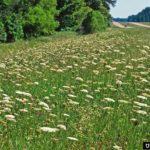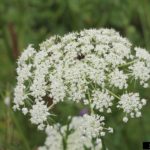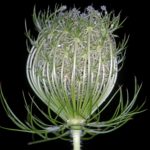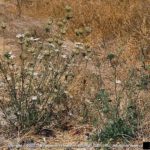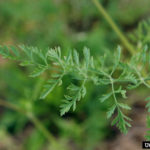Gallery:
- Wild carrot infestation
- Wild carrot flower profile
- Wild carrot flower, top view
- Wild carrot in seed
- Wild carrot
- Wild carrot leaf
Common names:
wild carrot, Queen Anne’s lace, bird’s nest
Scientific Name:
Daucus carota
Description:
Wild carrot is a mostly biennial plant in the Apiaceae (carrot) family, and is also commonly referred to as Queen Anne’s Lace. Wild carrot is also the ancestor of the cultivated carrot and is widespread across the United States and Canada. It typically forms a rosette the first year, and produces flowers in the following years. Wild carrot is upright with a long taproot, a hairy stem, and finely divided leave similar to garden carrots. The white flower clusters are in umbrella shapes (umbels), 2-4 inches across, often with a few pinkish flowers in the middle. After it has gone to seed, the umbels turn upward. It is a prolific seeder, producing 1,000 to 40,000 seeds per plant, and so it can spread aggressively.
Life cycle:
Biennial or short-lived perennial
Height of mature plants
1 to 4 feet
Flower color:
white
Bloom time:
late spring through summer
Look-a-likes:
Wild carrot looks very similar to other plants in the carrot family. It may be confused with poison hemlock, which is a bigger plant with purple blotches on the stems. It can also look similar to wild chervil, which has distinct ridges on the stem. It can be distinguished from the cultivated carrot by the roots. Wild carrot has yellowish roots that are fibrous and become tough and woody. The small pinkish-purple flowers in the center, while not always present, are distinctive of wild carrot.
Habitat:
Wild carrot like sunny, dry habitats, and will thus grow in fields, weedy meadows, along railroad and roadsides, and in degraded prairies and fields.
Impacts:
Wild carrot invades open areas and can out-compete native plants because it often grows faster and larger. When it grows near cultivated carrots, there is danger of cross pollination, resulting in contaminated seed crop. Wild carrot can also harbor diseases and pests that can damage cultivated carrots. If dairy cows ingest large amounts, this plant can also taint their milk. It is difficult to control because of its deep taproot and is also resistant to mowing, since it can produce new stems from the rosettes.
Noxious Weed Listing:
- WeedWise: maintenance
- State of Oregon: not listed
- State of Washington: Class C
- Four County CWMA: Class C
- Columbia Gorge CWMA: Class C
Origin:
North Africa, Asia, and Europe
Links:
Washington Noxious Weed Profile
Invasive.org profile
CABI Invasive Species Compendium
UC Davis Weed Report

